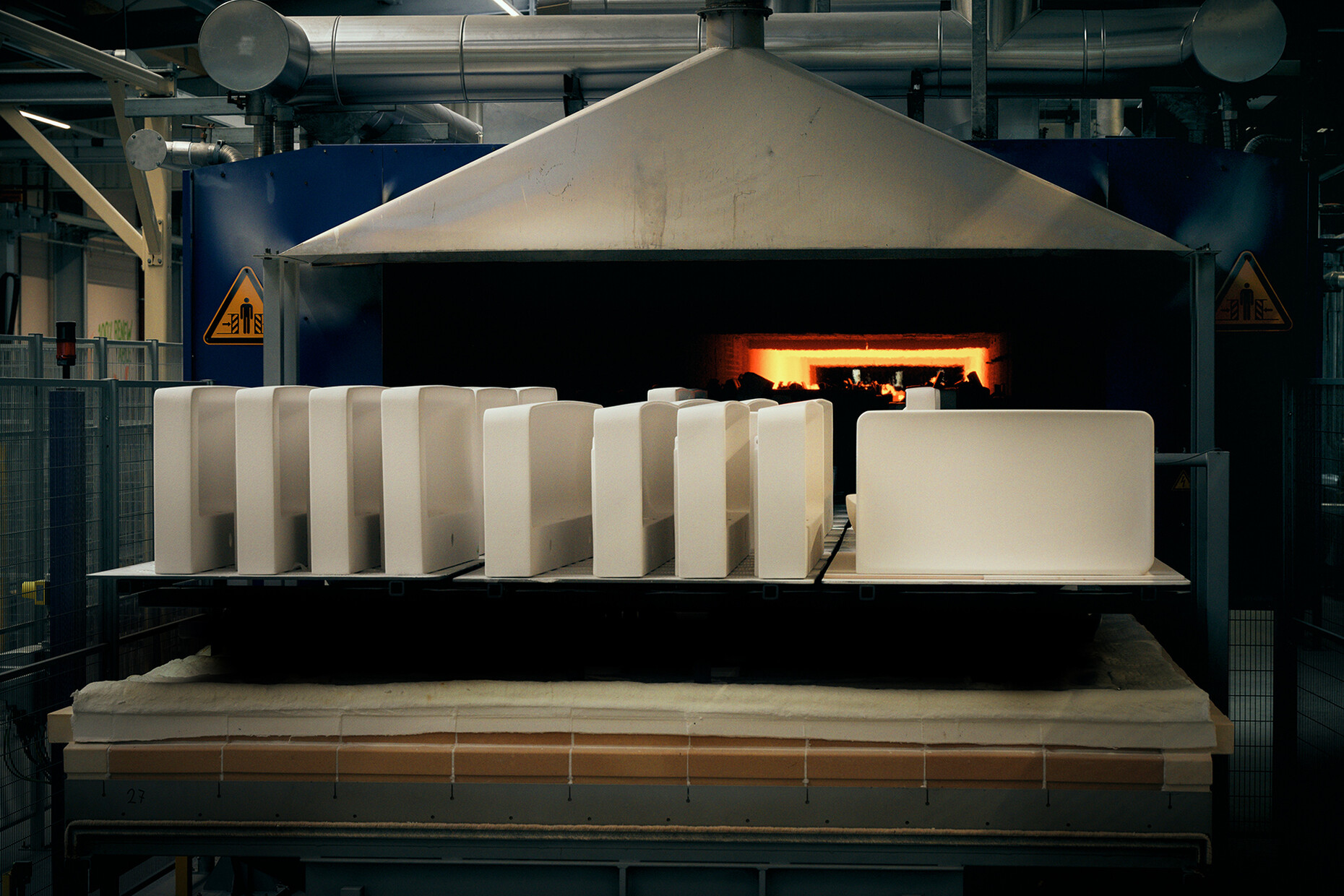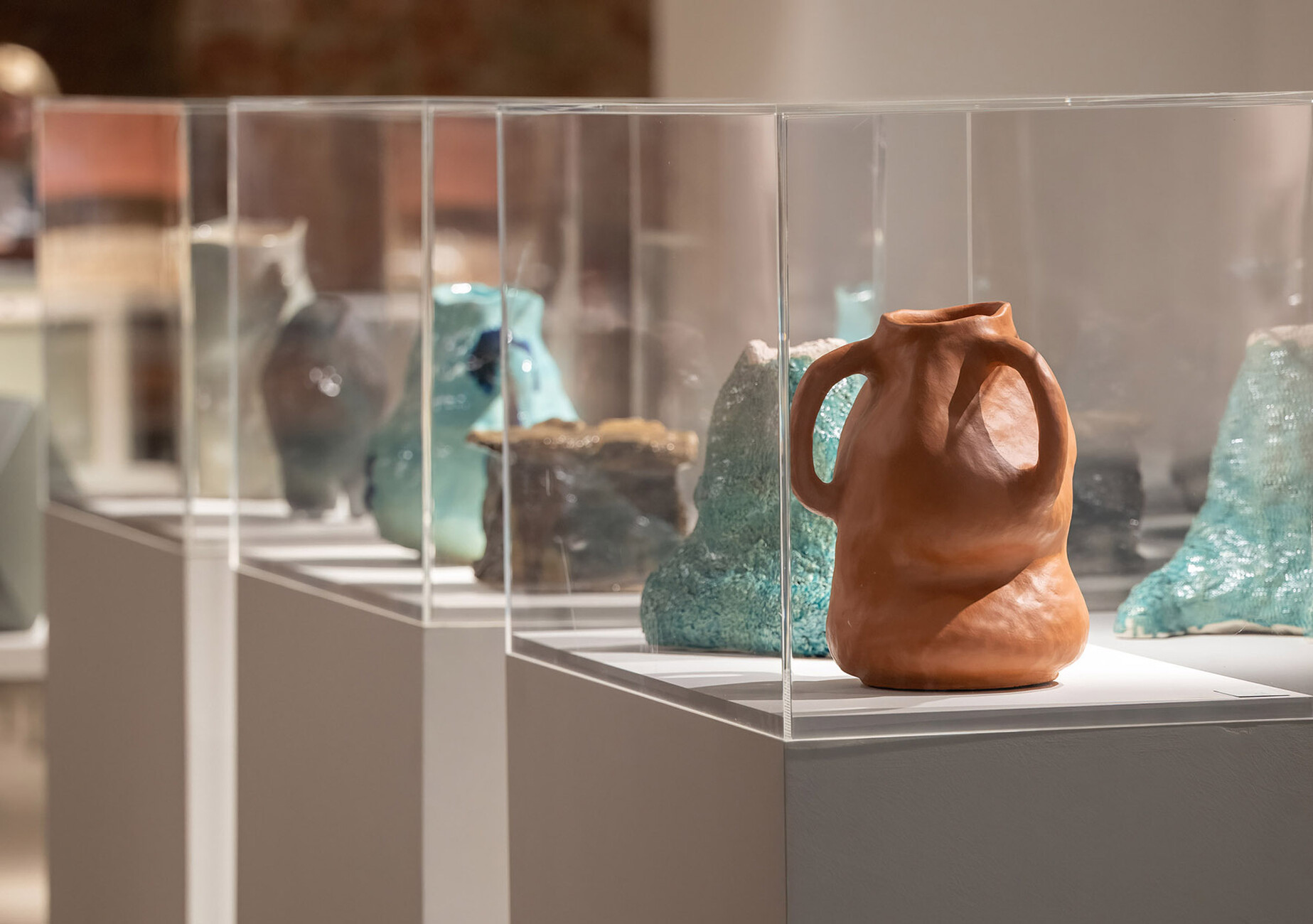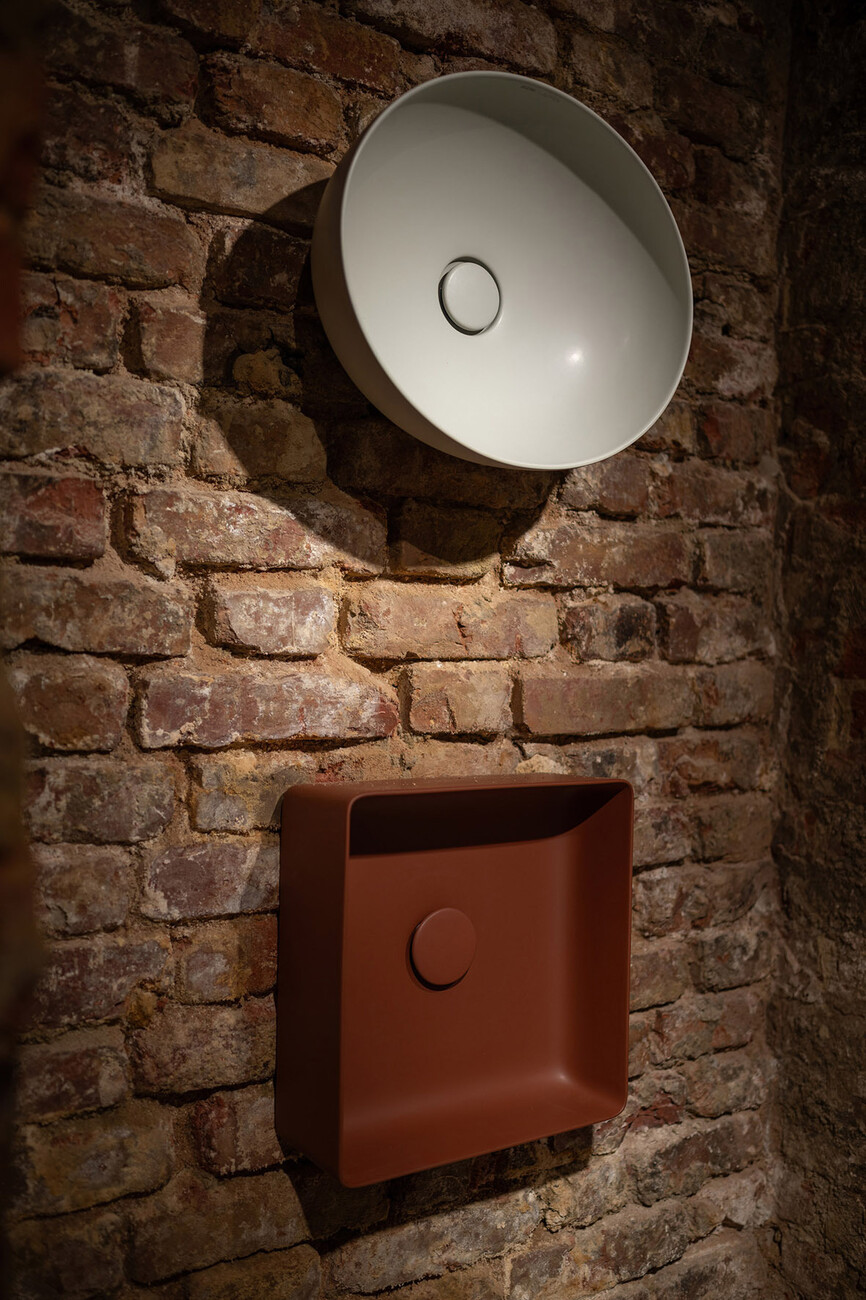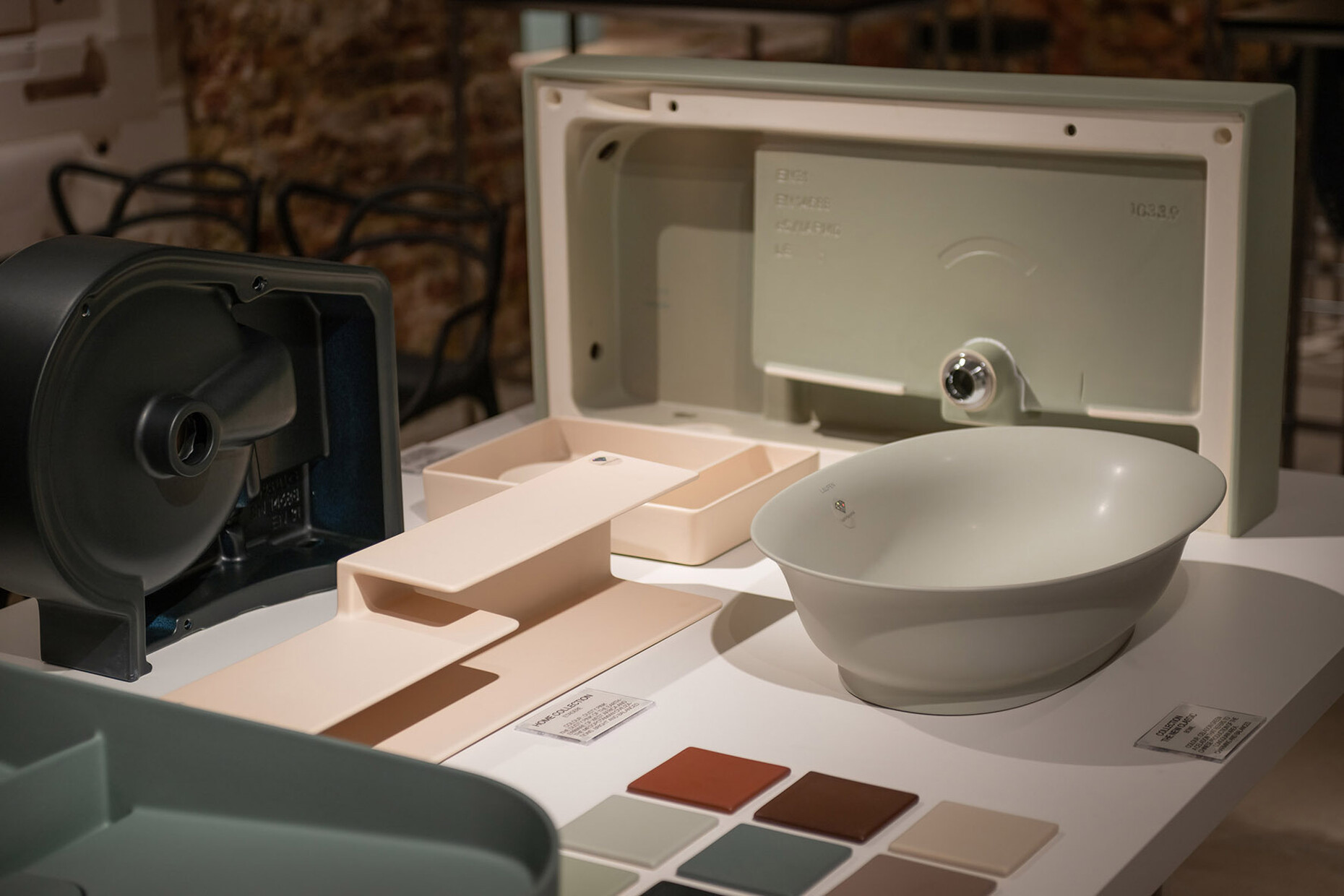STYLEPARK LAUFEN
The courage to change
Anna Moldenhauer: There's this saying, ‘Everyone said it couldn't be done, then someone came along who didn't know and just did it’ – what made Laufen decide to invest in the development of an electric tunnel kiln?
Christian Schaefer: That was a decision based on the development and direction of the company. We are part of the Roca Group, which has been pursuing the path of sustainability and social responsibility for a long time. We don't just write this on our banners, we live up to it. Our plants are certified to ISO 14.001, we have our own wastewater treatment facilities and practise a zero waste approach in order to utilise all resources as sensibly as possible. As a company, we have a responsibility, including to the public. Our production emits CO2 due to the firing process, so it was natural for us to think about how to optimise this process. Production in Gmunden, including the Laufen Group's innovation centre, offers ideal conditions for this kind of experimentation.
Can you provide a percentage figure to visualise how much CO2 can be saved by switching from gas to electricity from renewable sources?
Christian Schaefer: That also depends on the respective production site, the quantities, the state of the technology and how much gas is used in each case. It makes a big difference whether the oven is 40 years old or new. We emitted around five and a half thousand tonnes of CO2 per year, which is the equivalent of driving 40 million kilometres in a car. With the new technology, we can reduce CO2 emissions by an average of 50 kilos per ceramic piece. As an example: for the furnishing of a hotel project with 100 rooms, a good ten tonnes of CO2 can be saved. That definitely makes a difference.
The plant uses electricity from renewable energy sources and Laufen is also working on an energy concept that is both sustainable and self-sufficient. What is the current status?
Christian Schaefer: We are currently in the technical implementation phase. There are still a few unanswered questions because these are not technologies that are bought on the market, but new developments. That's why it's also a pilot project for us. As things stand today, it is feasible to adapt the production processes. We are confident that we will be completely CO2-free by 2025 at the latest. The products are already fired without CO2, but some of the halls are still operated with gas heating. These are now also being converted.
The new oven was developed with the company Keramischer Ofenbau, how can I imagine the co-operation and distribution of tasks?
Christian Schaefer: We understand the processes involved in producing ceramics, especially high-quality ceramics and complicated production methods. The mechanical engineering company Keramischer Ofenbau, on the other hand, is familiar with the hardware, with the technology of the kiln itself. In the course of development, we realised that we harmonise very well with each other. This enabled us to develop an electric furnace that was previously considered unrealisable in the industry. Our innovation manager Alfred Mittermeier simply stood up to it and said it had to be done. Together we found a way and showed that it is possible.
The Roca Group, to which Laufen belongs, has over 90 ovens. How long will it take to equip them with the new technology and how much effort will it take?
Christian Schaefer: The conversion is very complex, as the conditions at each location are different. In Gmunden, we have an excellent situation with an electricity capacity that could be flexibly converted. We were able to install PV systems that easily cover the total output of the kiln at peak times. But of course we don't just burn when the sun is shining, but 24 hours a day. Ongoing operation must be ensured. This is entirely possible in many countries and we will start with the conversion in these countries first and then work our way forward.
How does the new production method affect the products?
Christian Schaefer: When we started up the oven for the first time, the tension was very high as we had no comparative values. Fortunately, the result was good and the products were of the best quality. Of course, the tests and checks are still ongoing and, at the same time, we have the ambition to manufacture products in the future that would not be possible without the new technology and its fine control. In principle, we can now play the full range of different firing curves.
Can the quantities per year be increased?
Christian Schaefer: Of course, every oven is dimensioned for a certain capacity, but it would be possible to increase the number of units. I reckon we could easily go up to 150,000 pieces. In Gmunden, we produce around 100,000 pieces, mainly sapphire ceramics. There are plants where we produce over a million, and the kilns are correspondingly larger.
In order for the production of ceramics and related industries to be decarbonised, the patent-pending development would have to become the standard – how do you intend to make this possible?
Christian Schaefer: With regard to the new technology, we can certainly speak of a paradigm shift. The Group will continue to invest in this, including the integration of Keramischer Ofenbau into the Roca Group. However, if we are the only ones firing with electric kilns, the environment will not benefit. Our CEO has made it very clear that the technology is available to everyone and there are now also many competitors who are interested in it. An electric stove is basically no more expensive than a modern gas stove. In the 1980s, we largely developed die casting, which is now an industry standard. I am firmly convinced that the new technology we have developed offers the future for our industry.
Sanitary ceramics are a product for the masses – production in Gmunden, on the other hand, resembles a manufactory, which is also where the sapphire ceramics were developed. Why is the concept successful for Laufen?
Christian Schaefer: It depends on the perspective. The concept works very well for us in Gmunden and is one of the reasons why we continue to produce in Central Europe, even though the labour cost factor in the DACH countries is quite high. Thanks to our innovation centre, we have the opportunity to test ideas quickly and develop them ready for production, as with the creation of sapphire ceramics. However, production in Gmunden alone does not make us number one in the industry, of course. We achieve this through our association with the Roca Group and the large volume that can thus be offered. The mixture of manufacturing and mass production is what makes us successful.
You have been working for Laufen for over ten years, i.e. you have helped shape the company – in which direction would you like to develop Laufen Austria AG as Managing Director?
Christian Schaefer: The market is becoming increasingly globalised. The general orientation of the Roca Group and the development of the European market are also influencing our direction. A few years ago, we were still exclusively a ceramics manufacturer, but today we work more as a full-service provider. In Switzerland, for example, we are already the market leader in the taps sector. We have also acquired Sanit, a major German manufacturer of installation systems. These investments also contribute to our ability to realise fittings both in front of the wall and behind the wall. This means that in future, Laufen will primarily stand for bathroom expertise and no longer ‘just’ for ceramics.
Are there any current events organised by Laufen that you would like to draw our readers' attention to?
Christian Schaefer: With Laufen Space Vienna, we have a great exhibition space in a very central location that has established itself over the last few years. During Vienna Design Week, we will be presenting the exhibition ‘Colour Archaeology’, an interdisciplinary journey through art, design, archaeology and the history of colour in ceramics by Roberto Sironi. The programme includes a keynote speech by Roberto Sironi and Patrick Lüth, Managing Director of Snøhetta Studio Innsbruck, on the archaeology of colour and visions of regenerative architecture. Architecture critic Manuela Hötzl will moderate the event. In addition, this year we are celebrating the 100th anniversary of our production in Gmunden, and part of the Salzkammergut cultural capital, in the context of which many events are currently taking place. As a sponsor of the Austrian pavilion, we are also represented at every edition of the Architecture Biennale in Venice.
Laufen space Vienna
Salzgries 2
11010 Vienna





















